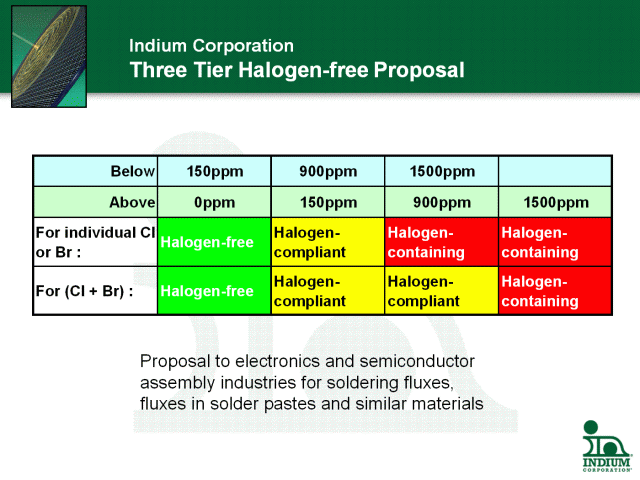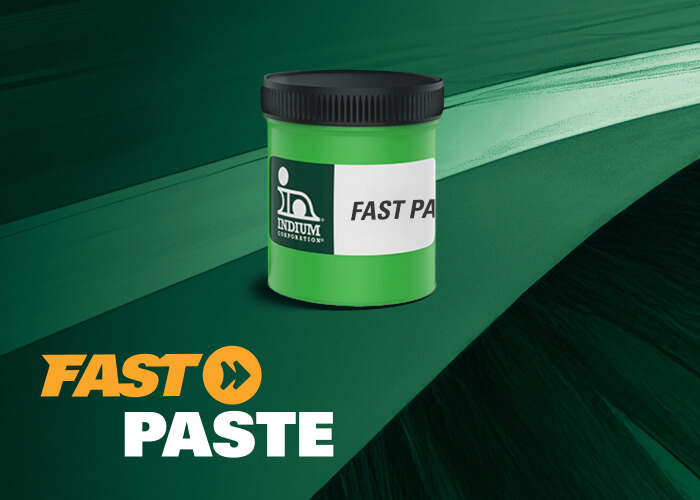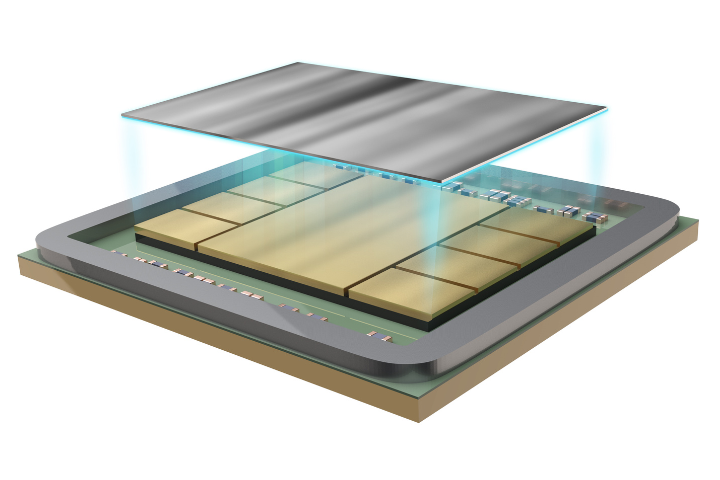As a supplier of electronics materials, Indium Corporation is constantly faced with customer requests for “halogen-free” (HF) soldering fluxes and associated materials. This is an interesting trend, but we face several challenges here:
1/ What is “halogen-free”? We have not seen any consistent message from our customers on what they mean by a halogen-free flux. As a materials-supplier this is an absolute show-stopper.
Based on several conversations with interested parties, my understanding of the IPC status is as follows, and apologies for any misunderstandings to Tim Jensen (Indium Corp.) and Tom Newton (IPC). The IPC’s 4-33a Task Group, which was looking at a universal halogen-free material standard (J-STD-709), saw a failure of a second ballot on the standard, even when it got downgraded to a guideline. The 4-33a group faced numerous differences of opinion: on what materials should be included; what halogen levels are allowable; or even whether a single component could be considered a “homogeneous material” to be ground up and analyzed for halogens and so on. The task of defining HF will now reportedly be taken up by two separate groups from IPC and JEDEC.
Meanwhile, in March of this year, the Japanese organization JEITA quietly released their understanding (ET-7304) of what is meant by HF fluxes and solder pastes, using a 1000ppm halogen limit. This definition is clearly at odds with the IEC’s definition of HF. That is, 900ppm by weight maximum of chlorine or bromine atoms, or a maximum of 1500ppm of both: the so-called “9-9-15” limit. .
2/ Which halogens? The strict definition of a Group VII element (halogen) is one of Fluorine (F), Chlorine (Cl), Bromine (Br), Iodine (I) and radioactive Astatine (At). From environmental reasons, chlorine and bromine in halogenated fire-retardant (HFR) materials that emit dioxins and similar compounds when heated should be eliminated. However, some customers are also throwing fluorine and iodine into this definition, too. This may be based on fears of electrical reliability, but from my perspective the customer is becoming defocused from the necessity of meeting environmental concerns.
3/ Does halogen = halogenated fire retardant? Not every halogen found in an electronic material is an indicator of a halogen-containing fire retardant!
Greenpeace is the main driver behind this, and I have, to date, been unable to get a response from them on how they will detect halogens on circuit boards. The fear from our customers, and our customers’ customers, is that an electronic device (iPhone / flat-screen TV or other) will be obtained by an environmental group; pulled apart; and X-ray fluorescence (XRF) used to detect halogens. The minimum sample size that can give a quantifiable result for halogen-free is reportedly 2grams: contrast this with the milligrams of material (residue) present from a no-clean flux in a cellphone, and you can see the issues in quantifying halogen levels based on flux residues. We can’t do it reliably.
4/ How can we confirm “zero” halogens? Contrast the JEITA standard with the requests from many customers for zero halogens / “no intentionally added” halogens / “elemental halogen-free” fluxes or some such. However, since many customers insist on third-party data-reporting, we are reliant on these analytical labs to reliably give us data. One of the challenges we face is when, for example, a lab reports “63ppm of chlorine”, based on a reported limit of detection (LOD) of 50ppm. Our customer is outraged: “You said it was halogen-free!”
Those of you familiar with the statistics of analytical chemistry will immediately see the two fallacies here: the first is that they have reported not the method detection limit (MDL), but the much-lower LOD. The MDL is a function of analytical equipment PLUS the errors in sample preparation and handling. The second fallacy is that you can not report 63ppm as a reliable, reproducible number, since the limit of quantitation (LOQ) – the limit at which you can actually give a figure for the concentration – is more than 3 x the MDL. The limit of analytical capability to reliably quantify the amount of halogen present is therefore around 150ppm or greater.
Instead of reporting “63ppm halogen”, a more accurate statement is: “In our single test, we found a small peak in our spectrum at the same elution time as a halide-ion. It may be a halogen, or it could be one of the millions of anionic organic species that elute at the same retention time. The quantity found is well below the method detection limit, so we have no way of knowing if it is from contamination during the sample preparation, and we certainly can not tell how much is present.”
5/ What is a ‘homogeneous material”? Some customer standards require the level of halogen in a homogeneous material to be reported. We can probably safely say that a flux is a “homogeneous material”, but is a solder paste truly homogeneous? Both JEITA and Indium Corporation can agree that the flux-content needs to be the focus of the analysis, but a solder paste supplier may, for example, take the analysis of a 90%w/w metal solder paste, and report the results as “890ppm chlorine”, knowing that the level in the (10%) flux is 8,900ppm chlorine, essentially diluted by the 90% metal content.
Conclusion:
As a global electronics materials supplier, we at Indium Corporation can see three possible solutions to all these dilemmas:
a/ Adopt the JEITA specification – even though it goes against the 9-9-15 EIC recommendation. This allows us to be on a level footing with our Japanese competitors, but appears to put us at odds with the needs of some of the semiconductor assembly and electronics assembly industries.
b/ Adopt a three-tier specification based on the IPC/IEC recommendation – the Indium Corporation approach is given here (below).
Why three levels? Because our more discriminating customers are telling us that truly halogen-free fluxes are simply not as effective as those that contain small amounts of halogen. For those who are concerned about end product reliability, a “halogen-compliant” tier allows the best of both worlds.
c/ Report the atomic chlorine and bromine levels present in the flux component, and allow the customer to choose what they want, based on this.
If you are a user of Indium Corporation materials, or even a competitor of ours – what makes most sense here? Or is there a fourth or fifth way?
Cheers! Andy




